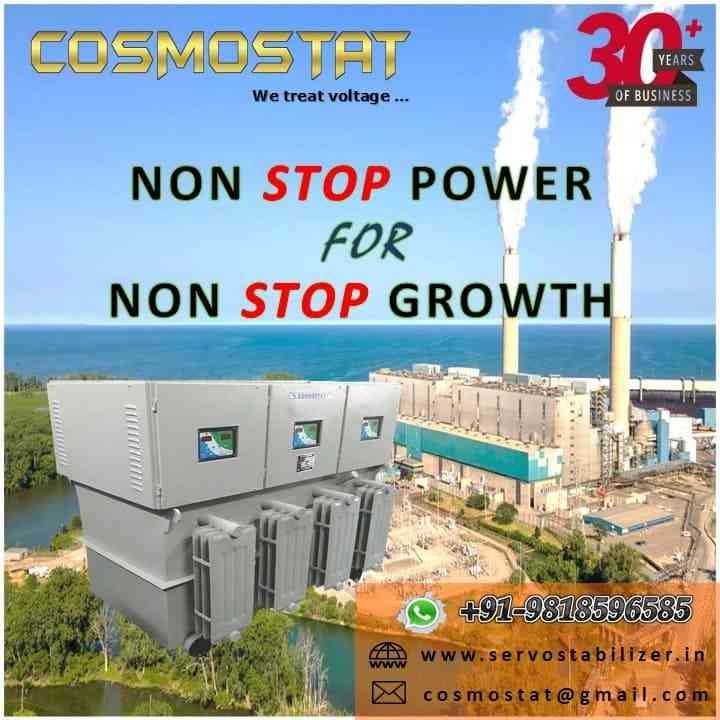
Servo Stabilizer for Industries
In the dynamic world of industries, a constant and reliable power supply is essential to ensure uninterrupted operations. This article delves into the significance of servo stabilizers and how they contribute to enhancing efficiency and reducing energy consumption within industrial setups.
Understanding Servo Stabilizers
Servo stabilizers are sophisticated devices designed to regulate and stabilize voltage levels. They work by continuously monitoring the incoming voltage and making instantaneous adjustments to maintain the desired voltage output. This proactive approach prevents voltage fluctuations from affecting sensitive equipment, safeguarding them from potential damage.
The Importance of Servo Stabilizers in Industries
Industries heavily rely on a range of electrical machinery, from high-powered motors to intricate electronic systems. Any deviation from the required voltage can lead to disruptions, affecting production schedules and product quality. Servo stabilizers act as guardians, ensuring that voltage variations do not impede the industrial processes.
How Servo Stabilizers Work
Servo stabilizers utilize advanced technology, including sensors, control circuits, and a precision motor-driven mechanism. When the input voltage fluctuates, the control circuit sends signals to the motor to adjust the position of the auto-transformer. This, in turn, regulates the output voltage to the desired level, compensating for any variations in the input.
Advantages of Using Servo Stabilizers
-
Enhanced Equipment Lifespan: By maintaining a steady voltage supply, servo stabilizers extend the operational life of industrial equipment.
-
Reduced Downtime: Minimized disruptions due to voltage fluctuations lead to increased productivity and reduced downtime.
-
Optimized Energy Consumption: Servo stabilizers help industries achieve energy efficiency by ensuring that equipment operates at their ideal voltage levels.
-
Voltage Correction: These stabilizers correct over-voltage and under-voltage conditions promptly, preventing damage to machinery and products.
Factors to Consider When Choosing a Servo Stabilizer
When selecting a servo stabilizer for industrial use, several factors come into play:
-
Voltage Range: The stabilizer should cover the entire voltage range experienced in the industrial setting.
-
Load Variability: Consider the variation in load and choose a stabilizer with the appropriate capacity.
-
Response Time: Faster response times are crucial to counter rapid voltage fluctuations effectively.
-
Compatibility: Ensure the stabilizer integrates seamlessly with existing equipment and control systems.
Installation and Maintenance of Servo Stabilizers
Proper installation and regular maintenance are key to ensuring the optimal performance of servo stabilizers. Consulting with experts for installation and adhering to maintenance schedules can prolong the lifespan of these devices.
Case Studies: Real-Life Benefits in Industrial Scenarios
Several industries have witnessed substantial improvements after implementing servo stabilizers. One such example is a manufacturing unit that experienced a significant reduction in equipment breakdowns, leading to enhanced productivity and cost savings.
Energy Efficiency and Cost Savings
Beyond voltage stabilization, servo stabilizers contribute to energy efficiency. By maintaining optimal voltage levels, energy consumption is streamlined, resulting in reduced electricity bills and a smaller carbon footprint.
Future Trends in Servo Stabilizer Technology
As technology continues to evolve, servo stabilizers are expected to become even more sophisticated. Integration with smart control systems, predictive maintenance capabilities, and enhanced energy monitoring are among the anticipated advancements.
Conclusion
Servo stabilizers stand as essential components in the industrial realm, ensuring the seamless operation of equipment, minimizing downtime, and promoting energy efficiency. Their role in maintaining stable voltage levels cannot be overstated, and as industries continue to grow, the reliance on these devices will only increase.

